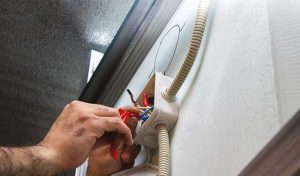Wiring problems are all too common. If your home was built decades ago, the wiring practices would have been faulty and not up to current codes. However, contractors for new homes don’t always have a professional electrician doing all of the electrical work either, which can result in shortcuts and mistakes.
Wiring problems can be very dangerous and require calling for professional residential electrical repair in Anaconda, MT, so it’s important to know what to watch out for. To help protect your home and your family, here are 6 common home wiring problems to be aware of:
- Wiring that is too close to nails or screws
If the wiring is too close to the path of a nail or screw, there is the possibility of the wire being punctured, which can result in a fire. A clearance of 1 ¼ in. must be maintained between the wire and the edge of a stud in order to protect the wire from long nails and screws.
- Too many wires in a switch box or outlet box
An outlet box with too many wires in it can overheat. When the outlet box overheats, it can melt the insulation around the wires which can potentially cause a fire. Be sure that a large enough outlet box is used for the number of wires that need to go into it.
- New fixtures installed to old wires
Many older homes were built with wiring that can only handle up to 60 degrees Celsius, while most modern lighting fixtures have wiring for up to 90 degrees Celsius. A new lighting fixture connected to old wiring can create heat that can overpower the older wires’ capacity and cause a fire.
- Holes crowded with too many wires
Running too many wires through the same drilled hole can cause friction between the wires, which can result in overheating and cause a fire. Be sure to drill holes that are large enough to handle the number of wires that need to go through them.
- Keep low and line voltage apart
If a low-voltage wire comes in contact with a line-voltage wire, the higher voltage can travel down the low-voltage wire and damage whatever appliance or electronic is on the other end. Be sure to maintain a minimum of 6 in. between parallel runs and don’t bring low-voltage and line-voltage wires together in the same box.
- Don’t install smoke detectors too close to air ducts
If a smoke detector is wired too close to an air duct, the flow of air can interfere with the effectiveness of the smoke detector. Make sure that there’s at least 36 in. between any air ducts and your smoke alarm.
Watching out for these 6 common mistakes can help protect your home and family. However, if you do come across any of these mistakes, don’t try to fix the problem yourself. Be sure to call for professional residential electrical repair in Anaconda, MT.



